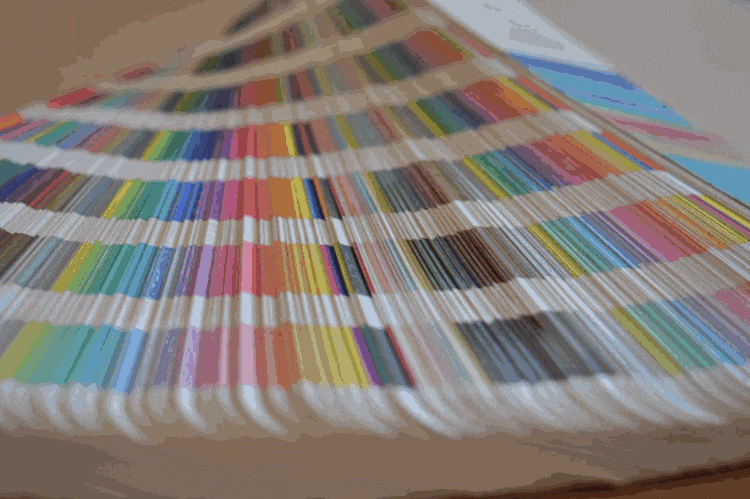Adobe Steals Your Color
Adobe steals your color

When a company breaks a product you rely on — wrecking decades of work — it’s natural to feel fury. Companies know this, so they try to deflect your rage by blaming their suppliers. Sometimes, it’s suppliers who are at fault — but other times, there is plenty of blame to go around.
For example, when Apple deleted all the working VPNs from its Chinese App Store and backdoored its Chinese cloud servers, it blamed the Chinese government. But the Chinese state knew that Apple had locked its devices so that its Chinese customers couldn’t install third-party apps.
That meant that an order to remove working VPNs and apps that used offshore clouds from the App Store would lock Apple customers into Chinese state surveillance. The order to block privacy tools was a completely foreseeable consequence of Apple’s locked-down “ecosystem.”
https://locusmag.com/2021/01/cory-doctorow-neofeudalism-and-the-digital-manor/
In 2013, Adobe started to shift its customers to the cloud, replacing apps like Photoshop and Illustrator with “Software as a Service” (“SaaS”) versions that you would have to pay rent on, every month, month after month, forever. It’s not hard to understand why this was an attractive proposition for Adobe!
Adobe, of course, billed its SaaS system as good for its customers — rather than paying thousands of dollars for its software up front, you could pay a few dollars (anywhere from $10-$50) every month instead. Eventually, of course, you’d end up paying more, assuming these were your professional tools, which you expected to use for the rest of your life.
For people who work in prepress, a key part of their Adobe tools is integration with Pantone. Pantone is a system for specifying color-matching. A Pantone number corresponds to a specific tint that’s either made by mixing the four standard print colors (cyan, magenta, yellow and black, AKA “CMYK”), or by applying a “spot” color. Spot colors are added to print jobs after the normal CMYK passes — if you want a stripe of metallic gold or a blob of hot pink, you specify its Pantone number and the printer loads up a separate ink and runs your media through its printer one more time.
Pantone wants to license this system out, so it needs some kind of copyrightable element. There aren’t many of these in the Pantone system! There’s the trademark, but that’s a very thin barrier. Trademark has a broad “nominative use” exception: it’s not a trademark violation to say, “Pantone 448C corresponds to the hex color #4a412a.”
Perhaps there’s a copyright? Well yes, there’s a “thin” database copyright on the Pantone values and their ink equivalents. Anyone selling a RIP or printer that translates Pantone numbers to inks almost certainly has to license Pantone’s copyright there. And if you wanted to make an image-editing program that conveyed the ink data to a printer, you’d best take a license.
All of this is suddenly relevant because it appears that things have broken down between Adobe and Pantone. Rather than getting Pantone support bundled in with your Adobe apps, you must now pay $21/month for a Pantone plugin.
https://twitter.com/funwithstuff/status/1585850262656143360
Remember, Adobe’s apps have moved to the cloud. Any change that Adobe makes in its central servers ripples out to every Adobe user in the world instantaneously. If Adobe makes a change to its apps that you don’t like, you can’t just run an older version. SaaS vendors like to boast that with cloud-based apps, “you’re always running the latest version!”
The next version of Adobe’s apps will require you to pay that $21/month Pantone fee, or any Pantone-defined colors in your images will render as black. That’s true whether you created the file last week or 20 years ago.
Doubtless, Adobe will blame Pantone for this, and it’s true that Pantone’s greed is the root cause here. But this is an utterly foreseeable result of Adobe’s SaaS strategy. If Adobe’s customers were all running their apps locally, a move like this on Pantone’s part would simply cause every affected customer to run older versions of Adobe apps. Adobe wouldn’t be able to sell any upgrades and Pantone wouldn’t get any license fees.
But because Adobe is in the cloud, its customers don’t have that option. Adobe doesn’t have to have its users’ backs because if it caves to Pantone, users will still have to rent its software every month, and because that is the “latest version,” those users will also have to rent the Pantone plugin every month — forever.
What’s more, while there may not be any licensable copyright in a file that simply says, “Color this pixel with Pantone 448C” (provided the program doesn’t contain ink-mix descriptions), Adobe’s other products — its RIPs and Postscript engines — do depend on licensable elements of Pantone, so the company can’t afford to tell Pantone to go pound sand.
Like the Chinese government coming after Apple because they knew that any change that Apple made to its service would override its customers’ choices, Pantone came after Adobe because they knew that SaaS insulated Adobe from its customers’ wrath.
Adobe customers can’t even switch to its main rival, Figma. Adobe’s just dropped $20b to acquire that company and ensure that its customers can’t punish it for selling out by changing vendors.
Pantone started out as a tech company: a way to reliably specify ink mixes in different prepress houses and print shops. Today, it’s an “IP” company, where “IP” means “any law or policy that allows me to control the conduct of my customers, critics or competitors.”
https://locusmag.com/2020/09/cory-doctorow-ip/
That’s likewise true of Adobe. The move to SaaS is best understood as a means to exert control over Adobe’s customers and competitors. Combined with anti-competitive killer acquisitions that gobble up any rival that manages to escape this control, and you have a hostage situation that other IP companies like Pantone can exploit.
A decade or so ago, Ginger Coons created Open Colour Standard, an attempt to make an interoperable alternative to Pantone. Alas, it seems dormant today:
http://adaptstudio.ca/ocs/
Owning colors is a terrible idea and technically, it’s not possible to do so. Neither UPS Brown nor John Deere Green are “owned” in any meaningful sense, but the companies certainly want you to believe that they are. Inspired by them and Pantone, people with IP brain-worms keep trying to turn colors into property:
https://onezero.medium.com/crypto-copyright-bdf24f48bf99
The law is clear that colors aren’t property, but by combining SaaS, copyright, trademark, and other tech and policies, it is becoming increasingly likely that some corporation will stealing the colors out from under our very eyes.
[Image ID: A Pantone swatchbook; it slowly fades to grey, then to black.]
More Posts from Misscounterfactual and Others







BMW iX Flow featuring E Ink !
With the BMW iX Flow featuring E Ink being presented on the occasion of CES 2022, the Munich-based premium car manufacturer is offering the prospect of a future technology that uses digitisation to adapt the exterior of a vehicle to different situations and individual wishes. The surface of the BMW iX Flow featuring E Ink can vary its shade at the driver’s prompting.
Celebrate Earth Day with NASA

"We came all this way to explore the Moon, and the most important thing is that we discovered the Earth." - Apollo 8 astronaut Bill Anders
On Dec. 24, 1968, Anders snapped this iconic photo of "Earthrise" during the historic Apollo 8 mission. As he and fellow astronauts Frank Borman and Jim Lovell became the first humans to orbit the Moon, they witnessed Earth rising over the Moon's horizon. The image helped spark the first #EarthDay on April 22, 1970.
Anders sat down with Dr. Kate Calvin, our chief scientist and senior climate advisor, to chat about the photo, and NASA’s role in studying our home.
Make sure to follow us on Tumblr for your regular dose of space!

Boo! Did we get you? 🎃
This solar jack-o-lantern, captured by our Solar Dynamics Observatory (SDO) in October 2014, gets its ghoulish grin from active regions on the Sun, which emit more light and energy than the surrounding dark areas. Active regions are markers of an intense and complex set of magnetic fields hovering in the sun’s atmosphere.
The SDO has kept an unblinking eye on the Sun since 2010, recording phenomena like solar flares and coronal loops. It measures the Sun’s interior, atmosphere, magnetic field, and energy output, helping us understand our nearest star.
Grab the high-resolution version here.
Make sure to follow us on Tumblr for your regular dose of space!


Guy Bluford Changed the Course of Space History
On Aug. 30, 1983, Guion Bluford, better known as Guy, became the first African American to fly to space. An accomplished jet pilot and aerospace engineer, Bluford became part of NASA’s 1978 astronaut class that included the first African American, the first Asian American, and the first women astronauts.
He and the other crew members of mission STS-8 were aboard the orbiter Challenger as it lifted off from Kennedy Space Center in Florida; it was the first nighttime launch and landing of the Space Shuttle program. While aboard, he and the other crew members deployed the Indian National Satellite (INSAT-1B), operated a Canadian-built robot arm, conducted experiments with live cell samples, and participated in studies measuring the effects of spaceflight on humans.
Guy Bluford chased his childhood dream of becoming an aerospace engineer, and in doing so, changed history and encouraged other Black astronauts to follow in his footsteps.
Make sure to follow us on Tumblr for your regular dose of space—and for milestones like this!

source
-
 mathlann reblogged this · 10 months ago
mathlann reblogged this · 10 months ago -
 pleasantpedanticny liked this · 1 year ago
pleasantpedanticny liked this · 1 year ago -
 jellyfishmakeoutparty liked this · 2 years ago
jellyfishmakeoutparty liked this · 2 years ago -
 indiepilled liked this · 2 years ago
indiepilled liked this · 2 years ago -
 misscounterfactual reblogged this · 2 years ago
misscounterfactual reblogged this · 2 years ago -
 perhapsihavesucceeded reblogged this · 2 years ago
perhapsihavesucceeded reblogged this · 2 years ago -
 purpleweredragon liked this · 2 years ago
purpleweredragon liked this · 2 years ago -
 professor-walnut liked this · 2 years ago
professor-walnut liked this · 2 years ago -
 capadipdap reblogged this · 2 years ago
capadipdap reblogged this · 2 years ago -
 capadipdap liked this · 2 years ago
capadipdap liked this · 2 years ago -
 bigblackbutterfly reblogged this · 2 years ago
bigblackbutterfly reblogged this · 2 years ago -
 dreamingbright liked this · 2 years ago
dreamingbright liked this · 2 years ago -
 invidiavoncarstein reblogged this · 2 years ago
invidiavoncarstein reblogged this · 2 years ago -
 invidiavoncarstein liked this · 2 years ago
invidiavoncarstein liked this · 2 years ago -
 aurinko-inen liked this · 2 years ago
aurinko-inen liked this · 2 years ago -
 crassjellyfish liked this · 2 years ago
crassjellyfish liked this · 2 years ago -
 mleggie reblogged this · 2 years ago
mleggie reblogged this · 2 years ago -
 umberandmochaagate reblogged this · 2 years ago
umberandmochaagate reblogged this · 2 years ago -
 umberandmochaagate liked this · 2 years ago
umberandmochaagate liked this · 2 years ago -
 cryoverkiltmilk reblogged this · 2 years ago
cryoverkiltmilk reblogged this · 2 years ago -
 electric-origami reblogged this · 2 years ago
electric-origami reblogged this · 2 years ago -
 dancingfishees liked this · 2 years ago
dancingfishees liked this · 2 years ago -
 babyithinkillrefrain reblogged this · 2 years ago
babyithinkillrefrain reblogged this · 2 years ago -
 missjudge-me reblogged this · 2 years ago
missjudge-me reblogged this · 2 years ago -
 stormy-seasons reblogged this · 2 years ago
stormy-seasons reblogged this · 2 years ago -
 stormy-seasons reblogged this · 2 years ago
stormy-seasons reblogged this · 2 years ago -
 adjoint-law reblogged this · 2 years ago
adjoint-law reblogged this · 2 years ago -
 lurkersupreme liked this · 2 years ago
lurkersupreme liked this · 2 years ago -
 ixalia reblogged this · 2 years ago
ixalia reblogged this · 2 years ago -
 renohasbigtits liked this · 2 years ago
renohasbigtits liked this · 2 years ago -
 blackmoonrose13 reblogged this · 2 years ago
blackmoonrose13 reblogged this · 2 years ago -
 kainamite15 reblogged this · 2 years ago
kainamite15 reblogged this · 2 years ago -
 kainamite15 liked this · 2 years ago
kainamite15 liked this · 2 years ago -
 depizan liked this · 2 years ago
depizan liked this · 2 years ago -
 retaliatesfirst reblogged this · 2 years ago
retaliatesfirst reblogged this · 2 years ago -
 true0neutral reblogged this · 2 years ago
true0neutral reblogged this · 2 years ago -
 fauxfire76 reblogged this · 2 years ago
fauxfire76 reblogged this · 2 years ago -
 fauxfire76 liked this · 2 years ago
fauxfire76 liked this · 2 years ago -
 inquisitorlavcllan liked this · 2 years ago
inquisitorlavcllan liked this · 2 years ago -
 ixalia liked this · 2 years ago
ixalia liked this · 2 years ago -
 thessalian reblogged this · 2 years ago
thessalian reblogged this · 2 years ago -
 keridar reblogged this · 2 years ago
keridar reblogged this · 2 years ago -
 sewallyfrustrated reblogged this · 2 years ago
sewallyfrustrated reblogged this · 2 years ago -
 inner8andtheisms reblogged this · 2 years ago
inner8andtheisms reblogged this · 2 years ago -
 the-cimmerians liked this · 2 years ago
the-cimmerians liked this · 2 years ago -
 meret118 reblogged this · 2 years ago
meret118 reblogged this · 2 years ago -
 foreverbitterabout13 liked this · 2 years ago
foreverbitterabout13 liked this · 2 years ago -
 whatdoyoumeanitsnotawesome reblogged this · 2 years ago
whatdoyoumeanitsnotawesome reblogged this · 2 years ago




